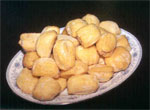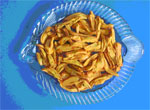| |
|
|
|
|
|
|
|
|
 |
| |
|
| |
Jackfruit can be processed into many products. The jackfruit's strong aroma accounts for the popularity of its processed products.
In order to process the fruit, the skin has to be removed first. Sticky latex from the fruit will ooze out when the tough scaly skin is cut causing some difficulties. Therefore it is usual for workers to smear their hands and knives with a film of edible oil before cutting the fruit. In doing so, minimal latex will stick to their utensils and hands which can then be washed off with detergent and water. The fruit skin is usually slit longitudinally to expose a mass of fruitlets or bulbs (flesh and seed) that are embedded between strands of unformed parthenocarpic fruitlets. The bulbs are then sliced off the skin and removed from the fruitlet strands. They can then be deseeded to obtain the flesh. |
| |
|
| |
Jackfruit slices may be canned in syrup. Jackfruit bulbs are cut into rectangular pieces about 2-2.5 cm wide. The slices of fruit are then soaked in a solution of 0.1% calcium chloride for 2 hours followed by washing and rinsing before filling into lacquered cans.
Jackfruit slices are canned in syrup of 40° Brix containing 0.2% citric acid, which is heated up to 83°C before pouring into the can. An alternative method is to use syrup at 30° Brix containing 0.1% citric acid and 0.1% of calcium chloride, at 90°C for packing with the jackfruit slices.
After the exhausting process, whereby air is removed from the cans, the cans are seamed, pasteurised in boiling water and cooled. |
| |
|
| |
Fruit cordial is a soft drink composed of syrup and juice, with or without other edible portions, of one or more types of fruit. A cordial should contain not less than 25% w/v of the juice and other portions of one or more types of fruit. Jackfruit cordial is usually processed using fruit puree that is mixed with water, sugar and citric acid. This mixture is heated up to 95°C in order to pasteurise it until it reaches 48-55° Brix. The product is golden yellow. Fruit cordials are allowed to contain permitted preservatives, permitted colouring substances, permitted flavouring substances and permitted food conditioners. |
| |
|
| |
Cryogenic freezing is a method that has the potential to extend the shelf life of jackfruit. Whole jackfruit bulbs that have been soaked in a mixture of 0.15% ascorbic acid and 0.2% calcium chloride in a 22° Brix are frozen cryogenically at –80°C using liquid nitrogen as the freezing agent. In cryogenic freezing, food products that have been thinly wrapped or food products that have not been wrapped are exposed to the freezing agent that is extremely cold eg. liquid nitrogen or carbon dioxide.
Cryogenic freezing helps to maintain the original taste and colour of the fruit while minimising the loss in quality and texture. Jackfruit that is frozen at –80°C can be kept at –20°C for at least a year. When defrosted with a microwave, the jackfruit will retain good texture and colour.

Frozen jackfruit |
| |
|
| |
Vacuum-fried jackfruit is a commercially produced non-oily snack. It is popular in Japan, Taiwan, Malaysia and Vietnam due to its strong unique flavour and crispness. The product is prepared by first freezing the jackfruit strips before frying it in a vacuum fryer until crisp. The vacuum fryer is able to remove the water from the jackfruit under vacuum, at temperatures lower than 100°C, as compared to normal frying which usually takes place at 120-270°C. The product is then removed from the vacuum fryer, allowed to cool and then centrifuged using a centrifugal basket for 5-10 min to remove excess oil before packing in suitable packaging material.

Vacuum fried jackfruit |
| |
|
Jams, jellies and marmalade
|
|
| |
Jackfruit can also be made into jam, jelly and marmalade. Jam, jelly and marmalade may contain permitted preservatives, permitted colouring substance, permitted flavouring substance and permitted food conditioner. All three products are shelf stable and can be kept for at least a year.
Jam is prepared by cooking one or more type of sound fruits, whether raw, processed or semi-processed, with permitted sweetening substances, with or without the addition of pectin. Jam must not have less than 35% of fruit. The blended fruit is cooked together with sugar, with or without additional pectin and citric acid until it reaches a minimum amount of 65° Brix soluble solids. It is then hot filled into glass bottles and capped.
Jelly is a gelatinous product produced by cooking 35% of fruit juice extract with a permitted sweetening agent, with or without additional pectin and acid to a soluble solids content of at least 65° Brix. The product is then packed into bottles. Marmalade is a clear jelly which contains slices of fruits or the skin of the fruit. |
| |
|
| |
Jackfruit Seed Flour
Flour can be produced from the fresh seed of the jackfruit by using a dryer to dry the seed until the moisture content is less that 5%. The dried seeds are then converted into powder by using a machine called a “hammer mill”.
Boil the seeds for 10 min in an open kettle after which the membranes are peeled off. Cut the seeds into small pieces and dry them at 65°C in a dryer to a moisture content of 3%. Mill the dried pieces into flour using a hammer mill. This flour can be used to prepare crisps. To make crisps, sieve jackfruit seed flour with a 0.5 mm mesh and mix it with tapioca flour in a ratio of 4:1. Add a 2% salt solution and steam the dough for 30 minutes. Store overnight at -10°C. Slice into 3 mm thick slices and dry at 60°C until 3% moisture before deep frying. The crisps produced have a distinct jackfruit flavour.
Dried Jackfruit
Dried jackfruit is produced by first soaking the jackfruit flesh in 2% salt solution containing 0.4% citric acid, followed by blanching in boiling water. The flesh is then cooled and further soaked in water containing sulphur dioxide at a level of 0.2% for 15 min. After draining, the flesh is dried in a drying cabinet at a temperature of 60-65°C until the moisture content has decreased to 5%. A high content of moisture will cause the dry product to be soggy, clumpy, mouldy and unsuitable to be kept for long periods of time. The dried product is usually packed and kept at ambient temperature. Rehydration of dried jackfruit is done by soaking the dried fruit in water containing 1% salt at 65°C for 30 min. This will result in jackfruit with the texture of fresh fruit.
Candied Fruit
Candied jackfruit is prepared by blanching the fruit flesh in boiling water for 2-3 min followed by soaking in a 40° Brix syrup containing 350 ppm (parts per million) of sodium benzoate overnight. The concentration of the syrup is increased at the rate of 5° Brix daily until it reaches 45° Brix. The final increment to 50° Brix is done with glycerol that is mixed with 0.1% sodium metabisulphite and 0.1% citric acid. The concentration is maintained at this level for 2 days. Jackfruit is then dried at 50°C for 24 hours, cooled, left for a sweating process of 24 hours to stabilise the moisture, and dried again at 100°C for 2 hours to attain a moisture content of less than 18%. This is then cooled before packing in suitable packaging materials. Candied jackfruit can be eaten fresh or used in cakes, yoghurts, ice creams and many other products. The product can be kept for 6 months at ambient temperature when packed.
Jackfruit Roll
Jackfruit can be processed into a fruit roll, a type of leathery fruit snack that is also known as fruit leather. The fruit flesh is blended with water until fine and then mixed with sugar, glucose syrup, citric acid, pectin and maltodextrin. This mixture is cooked until thick and then poured to form a layer of 1-2 mm thick in non-stick trays that are greased with 0.3% vegetable oil to prevent sticking. The product is then dried in a dryer at 90°C for one hour followed by 60°C for 2-3 hours. The product is removed from the tray, lined with a thin plastic film, cut to the required size and rolled. The jackfruit rolls can then be packed in a thermoform container sealed in oriented polypropylene-polyethylene film.
Fruit leather products can also be made from undeveloped perianth or unfertilised floral parts of jackfruit. The product had low moisture content, suggesting that it can be eaten as an intermediate moisture food. The product is most stable when packaged in laminated aluminium foil.
Freeze-dried Jackfruit
Freeze-dried jackfruit is commercially produced and sold as a snack. To process it, the fruit flesh in strips is frozen in freezing equipment before it is dried in a freeze dryer under vacuum. In this machine, ice is converted into vapour without turning into liquid first. This process produces products that are dry, crispy and ready to be eaten. |
| |
|
| |
|
| |
| |
| |
| |
|
|
 |
 |
 |
| Names |
| |
|
|
|
Artocarpus heterophyllus |
|
|
Common: |
|
English: |
Jackfruit |
Indonesia: |
Nangka |
Malaysia: |
Nangka |
Tagalog: |
Langka, Nangka |
Thai: |
Khanun |
Vietnam: |
Mít |
| Mandarin: |
Boluomi |
| Tamil: |
palap palam |
| Khmer: |
Khnol |
| Lao: |
Khanoon |
|
|
Taxonomic Position: |
| |
|
Domain: |
Eukaryota |
Kingdom: |
Viridiplantae |
Phylum: |
Spermatophyta |
| Subphylum: |
Angiospermae |
Class: |
Dicotyledonae |
Order: |
Urticales |
Family: |
Moraceae |
|
|
|
 |
 |
 |
|
| |
| |
|

